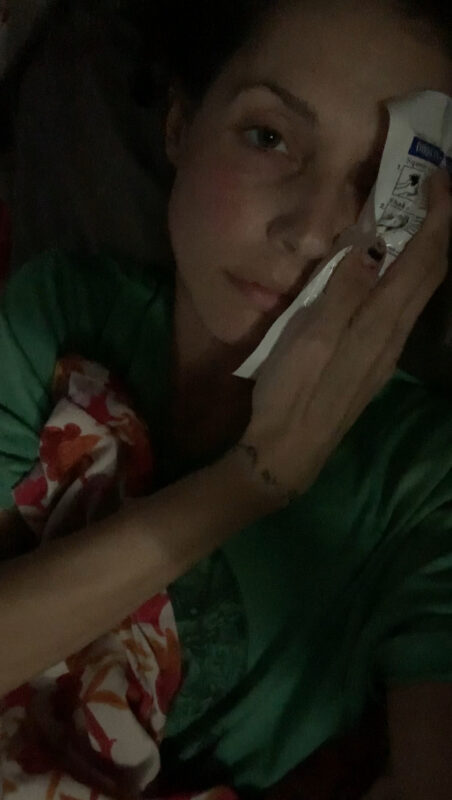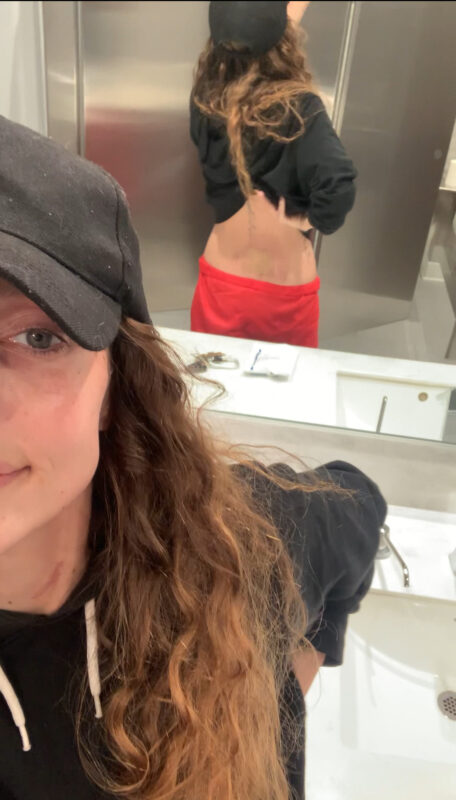I’m not allergic to steroid injections, but they’re making me sick
Despite the side effects, I continue with the shots in hopes of pain relief
Written by |
Note: This column describes the author’s own experiences with steroid injections. Not everyone will have the same response to treatment. Consult your doctor before starting or stopping a therapy.

Going in for injections is not that hot. (Photo by Bailey Anne Vincent)
“Why do I do this every time?” I asked my partner a day after receiving multiple steroid injections underneath the hardware in my lower back.
“You never know,” he replied, watching me writhe and whine with two ice packs on my face, which was newly the color of “Hadestown” flowers and felt like a sunburn without the smell of coconut. “It could work this time.”
I’ve had more steroid injections in my lifetime than I could possibly count. I’ve had them in my upper back, lower back, sacroiliac joint, and hips.
“I know that steroids are rarely worth it for me,” I said. “Yet I agree to take them anyway.”
I’ve been claiming that I’m growing “increasingly allergic” to steroids such as prednisone for years now, even though systemic hypersensitivity to steroids is uncommon. Even so, my reactions to them increase in severity every time.
Perhaps it was the long-term course of high-dose oral steroids I was on (including inhaled corticosteroids, commonly prescribed for those of us with cystic fibrosis). Maybe there’s some other scientific explanation. All I know is that the more they’re given, the more my body revolts.
“Can you do steroid injections under where we operated on my neck?” I’d asked the neurosurgeon naively during these most recent lumbar injections.

Ice packs all day are the only way. (Photo by Bailey Anne Vincent)
I am desperate, more often than not, for anything that will help. And steroids do help me 50% of the time for a short period of time — providing bursts of energy and a false sense of deep breathing.
But they also quadruple my anxiety to dangerous levels, make my face scaldingly hot (which I can live with), completely change my personality to something that resembles the closing lyrics of “Killing in the Name” by Rage Against the Machine (which I cannot live with, and neither can anyone in a 30-foot radius), and make it impossible for me to sleep.
“The only way for me to benefit from steroids is to never be around other people when I am on them,” I told my husband, essentially describing the exact opposite of why I take them: to do more, not less.
“If I could get a lidocaine shot in the nerve that’s been damaged on my left side, and it gave me a couple of hours of freedom from pain,” I continued with utter sincerity, “I would get an injection — as awful as they can be in sensitive areas — every single morning of my life.”
Because of the pain I feel, sitting, in any situation, hurts horribly.
“I don’t remember the last time I drove a car without pain,” I said to my husband, apparently trying to convince him of the daily lidocaine scenario that doesn’t medically exist. “If I were free from pain, how would it feel to sit and write something? To take a break? What would life be like? How would it feel to sit and have dinner, like we tried to do the other day?”
His face changed.
“That’s why I can’t talk about how terrible my quality of life is,” I continued, taking a cue from his nonverbal energy. “Because all the pain you saw when we sat in that booth to have a quick meal the other day? That was me hiding how much pain I was in.”
I stopped talking. He didn’t tell me to stop, but his face showed the invisible verbal dagger I’d twisted an extra inch through his heart.

Four Band-Aids, six or so shots, red pants. Let’s call it a day. (Photo by Bailey Anne Vincent)
I saw how much it hurt him to think about how much it hurts me just to exist. How much it hurt him to recognize that my quality of life hinges on taking medications that only work if I hide from people, in order to feel well enough to be around people (which, for those keeping count, cancel each other out).
But that didn’t make me want to stop talking. Instead, it made me want to say more.
“This isn’t fair!” I wanted to scream, as I imagined living a life without sitting or steroids — or, worse, a life with them. But I didn’t.
I pushed the ice packs harder against my face and wished I could twist the knife more so he could know how I feel, even though he’s an innocent bystander in every way.
“Why do I do this every time?” I repeated.
“Because they have nothing left to offer you,” he said.
The next day, I had my post-injection telehealth appointment with my neurosurgeon, and I told him about my daily lidocaine idea, among other medical ideas that aren’t humanly possible. Then, before we hung up the Zoom call, I said:
“Regarding the spot underneath my neck that hurts so badly — can we do injections there, too?”
Note: Cystic Fibrosis News Today is strictly a news and information website about the disease. It does not provide medical advice, diagnosis, or treatment. This content is not intended to be a substitute for professional medical advice, diagnosis, or treatment. Always seek the advice of your physician or other qualified health provider with any questions you may have regarding a medical condition. Never disregard professional medical advice or delay in seeking it because of something you have read on this website. The opinions expressed in this column are not those of Cystic Fibrosis News Today or its parent company, Bionews, and are intended to spark discussion about issues pertaining to cystic fibrosis.







Leave a comment
Fill in the required fields to post. Your email address will not be published.